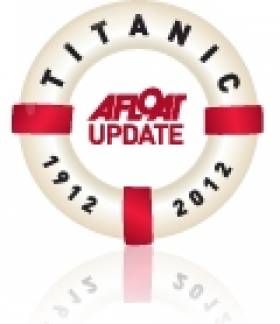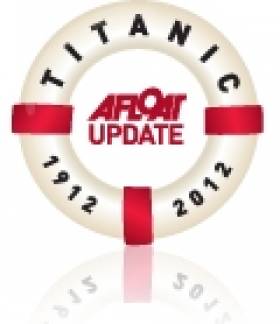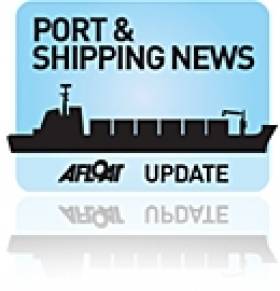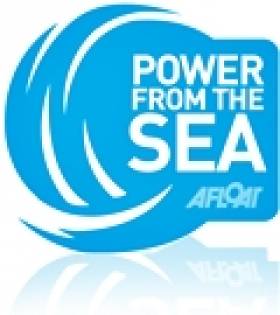Displaying items by tag: Harland and Wolff
#TITANIC - A Belfast man who saw the Titanic launch from the Harland and Wolff shipyards more than 100 years ago was guest of honour at the opening of Titanic Belfast at the weekend.
"It's like our Sydney Opera House," 105-year-old Cyril Quigley told BBC News of the £97 million (€116.7 million) visitor centre, opened on the 100th anniversary of the infamous ocean liner's tragic demise.
"My father and mother took me to Workman and Clark shipyard which is on the opposite side [of Belfast Lough] to watch the launch," he recalled to the Belfast Telegraph.
"I just saw a mass of metal in the gantries that they built for it and all I saw was this big thing sliding out into the water. I was only four-and-a-half."
Quigley described the new facility - designed to echo the imposing bow of the Titanic - as "wonderful", a sentiment echoed by Belfast Lord Mayor Niall O'Donnghaile who said: "The Titanic belongs to Belfast but this spectacle - Titanic Belfast - belongs to the world."
First Minister Peter Robinson was joined by Deputy First Minister Martin McGuinness at the ribbon cutting ceremony on Saturday 31 March, with the former declaring that this is "a new era in this province".
Titanic Belfast is expected to attract more than 400,000 visitors in its first year, and some 100,000 people have already purchased tickets. It will also be one of the largest employers and recruiters in Northern Ireland's tourism industry, as previously reported on Afloat.ie.
But the public's reaction so far has been mixed, according to The Irish Times, with some expressing disappointment at the lack of any large-scale model of the ship, and that the replica of the ship's famous staircase is hidden from public view in the venue's banqueting hall.
Titanic Belfast 'Is Designed to Impress'
#TITANIC - The Independent's Simon Calder reports on his special preview of Titanic Belfast, the £97 million (€116.3 million) tribute to the ill-fated ship on Belfast Lough.
"For once, the term 'of Titanic proportions' applies literally." he writes. "The top of the five-storey building is exactly as high as the tip of Titanic when the transatlantic liner was completed at the Harland and Wolff yard a century ago."
The monument is not only intended as a tribute to the tragedy, but also as a beacon to attract tourists to the "open, friendly city" of Belfast that has emerged after decades of the Troubles.
The travel writer compares the city's plans to the renaissance of Bilbao in northern Spain - like Belfast, a former shipbuilding centre damaged by terrorism that has become "a vibrant, elegant city that stands alongside Amsterdam, Barcelona and Berlin" thanks in part to the bold architecture of the Guggenheim museum.
Calder adds: "Almost every aspect of Titanic Belfast chimes with the city beyond the structure's metal jacket and big windows. And as with Titanic herself, the fitting out is designed to impress."
As previously reported on Afloat.ie, Titanic Belfast will be one of the largest employers in Northern Ireland’s tourism industry, as well as one of the North’s largest recruiters, when it opens later this month.
The Independent has much more on the story HERE.
Harland & Wolff Secure Dry-Docking Contract of Canadian FPSO
#PORTS & SHIPPING – Harland & Wolff Heavy Industries Ltd (H&W) have secured a contract to dry dock and service the Searose (2004/139,950dwt) a Canadian east coast based floating production storage and offloading (FPSO) vessel later this year.
The 272 metres long by 46 metre beamed FPSO is operated by Husky Oil and is based at the White Rose oilfield, 350km off the Newfoundland coast.
Searose will be dry-docked at H&W's Belfast Repair Dock and also use the Repair Quay during May and June. The work at the Queen's Island facility will be led by an integrated project team made up of owner and H&W personnel along with key contractors and vendors.
"H&W, along with our key contractors, are pleased to have secured the SeaRose FPSO project and to demonstrate the capabilities of the UK Oil & Gas supply chain," said H&W Project Manager James Lappin.
"This is an important opportunity, not only for H&W but for Northern Ireland, to extend a welcome to our Canadian visitors and demonstrate our world class facilities."
"We are proud that they have put their trust in us," H&W Chief Executive Officer Robert J Cooper said. "All levels of H&W are committed to ensuring this important project is completed safely and successfully."
H&W was founded over 150 years ago and has built some of the world's most famous ships, including three from the White Star Line: the Olympic, Titanic, and the Britannic, P&O's Canberra and the RN World War II battle-cruiser HMS Belfast, where she remains at moorings on the Thames.
Titanic Artifacts Surface at New Exhibition
Relics from the Titanic will get their first public airing at an exhibition in Co Down this month.
The Newsletter reports that the new display at Cultra's Folk and Transport Museum - which will be opened on 31 May - comprises 35 items from the doomed ship, including part of the hull, silver and glassware and a number of personal items.
"Nothing tells the story of Titanic more poignantly and dramatically than these artifacts," said Alexandra Klingelhofer of RMS Titanic Ltd, which has loaned the items to the museum.
The new exhibition marks 100 years since the launch of the Titanic from the Harland and Wolff shipyards in Belfast.
Harland and Wolff to build two Offshore Substations for Siemens
Siemens, a global powerhouse in electronics and electrical engineering, has awarded Harland and Wolff Heavy Industries Limited the design and build contract for two offshore substation platforms for the Gwynt y Môr offshore wind farm off the coast of North Wales. The substations will be completed by June 2012.
"We are already a recognised renewables logistics base and prototype builder and are delighted to have been awarded this contract. It clearly demonstrates our continuing development as part of the UK supply chain for marine renewable energy. Our project goals are to make the design and build process frictionless for Siemens and to ultimately provide the operator, RWE Innogy, with a robust and durable offshore platform, built safely,
on time and to budget.'
"A considerable number of these platforms are required to meet the Government's 2020 targets, giving substantial opportunities in the near future," says Mr Cooper.
The Gwynt y Môr offshore wind farm is a 576MW, 160 turbine UK Round 2 wind farm being developed by a consortium of RWE Innogy, SWM – Municipal Utility Munich, Germany and Siemens 13km off the coast of North Wales. Siemens will supply the wind turbines which will be connected via 33kV array cables to two new offshore substations.
Onboard the H&W built platforms Siemens' equipment will transform the power from 33kV up to 132kV for transmission back to a new onshore substation at St Asaph also to be built by Siemens.
John Willcock, director of Major Projects for Siemens Transmission and Distribution Ltd. Says: "Siemens is delighted to make this award to Harland and Wolff. This is a key project for Siemens, as one of the largest of its type ever developed. The H&W team impressed us by their approach to the project and understanding of our requirement.
This is a new relationship for both companies and one that could be fruitful in the future. It is great also to be able to support a UK-based firm."
Trevor McCormick, H&W Project Manager will have responsibility for the project in Belfast. He says: "This is a substantial project that will be the focus of our attention over the next two years. The project was secured due to a number of factors including the commitment demonstrated by all areas of the company during the tendering phase; we fully intend carrying this enthusiasm and dedication through to completion."
H&W, having decades of experience in offshore and marine projects for the oil, gas and shipbuilding industries, has designed the platform using stiffened panels typical of shipbuilding and offshore structures. This approach offers cost and weight savings, increased watertight integrity, structural flexibility and opens opportunities for floating, self-installing projects in the future.

































































